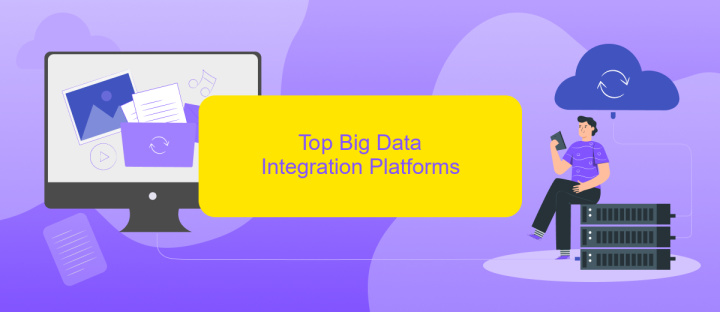Best Big Data Integration Platforms
In today's data-driven world, integrating vast amounts of data from various sources is crucial for businesses to gain actionable insights. Big Data integration platforms offer robust solutions to streamline this process, ensuring seamless data flow and enhanced analytical capabilities. This article explores the best Big Data integration platforms available, highlighting their key features, benefits, and how they can transform your data management strategies.
Introduction
In today's data-driven world, integrating diverse data sources is crucial for businesses aiming to harness the full potential of their information assets. Big data integration platforms play a vital role in simplifying this process, enabling seamless data flow across various systems and applications. These platforms offer robust tools to manage, transform, and analyze data, ensuring that organizations can make informed decisions based on comprehensive insights.
- Centralized data management
- Real-time data processing
- Scalability and flexibility
- Enhanced data quality and consistency
- Streamlined workflows and automation
One notable solution in this space is ApiX-Drive, a service designed to facilitate effortless integrations between different applications and systems. By leveraging ApiX-Drive, businesses can automate data transfers, reduce manual efforts, and ensure data accuracy. This not only saves time and resources but also enhances overall operational efficiency, making it an indispensable tool for modern enterprises.
Key Features to Consider

When evaluating Big Data integration platforms, it is crucial to consider scalability. The platform should be able to handle increasing volumes of data without compromising performance. Additionally, real-time data processing capabilities are essential for timely insights and decision-making. Look for platforms that support seamless integration with existing systems and offer a wide range of connectors for various data sources.
Another key feature to consider is ease of use. A user-friendly interface can significantly reduce the learning curve and improve productivity. Platforms like ApiX-Drive, which offer intuitive setup processes and automation of data workflows, can be particularly beneficial. Security is also paramount; ensure the platform provides robust data encryption and compliance with industry standards. Lastly, consider the platform's support and documentation, as these can be invaluable resources for troubleshooting and optimizing your integration processes.
Top Big Data Integration Platforms

Choosing the right big data integration platform is crucial for efficiently managing and analyzing vast amounts of data. These platforms help in seamlessly connecting various data sources, transforming data, and ensuring it is ready for analysis and reporting.
- Apache Nifi: An open-source platform designed to automate the flow of data between systems. It offers a user-friendly interface for designing data flows and supports a wide range of data formats and protocols.
- Talend: Known for its robust data integration capabilities, Talend provides tools for data preparation, integration, and quality checks. It supports both on-premises and cloud environments.
- ApiX-Drive: A versatile service that simplifies the process of integrating various applications and services. It allows users to create automated workflows without any coding, making it easier to manage and synchronize data across different platforms.
- Informatica: A comprehensive data integration tool that offers advanced features for data quality, governance, and security. It is suitable for large-scale enterprise environments.
- Microsoft Azure Data Factory: A cloud-based data integration service that enables the creation, scheduling, and orchestration of data workflows. It supports a wide range of data sources and destinations.
Each of these platforms offers unique features and capabilities, making them suitable for different business needs and technical requirements. By leveraging these tools, organizations can ensure their data integration processes are efficient, reliable, and scalable.
Benefits of Big Data Integration

Integrating big data from various sources can significantly enhance an organization's ability to make informed decisions. By consolidating data from multiple channels, businesses can gain a comprehensive view of their operations, customer behaviors, and market trends.
One of the key advantages of big data integration is the ability to streamline workflows and improve efficiency. When data is integrated seamlessly, it reduces the need for manual data entry and minimizes the risk of errors. This can lead to more accurate reporting and better strategic planning.
- Enhanced decision-making capabilities
- Improved data accuracy and consistency
- Streamlined operations and reduced costs
- Increased agility and faster response times
Platforms like ApiX-Drive facilitate the integration process by offering automated solutions that connect various data sources effortlessly. With ApiX-Drive, businesses can set up integrations quickly, without the need for extensive technical expertise, ensuring that data flows smoothly and is readily available for analysis.
- Automate the work of an online store or landing
- Empower through integration
- Don't spend money on programmers and integrators
- Save time by automating routine tasks
Conclusion
In conclusion, selecting the right Big Data integration platform is crucial for maximizing the potential of your data assets. The ideal platform should offer seamless integration capabilities, robust data processing, and scalability to handle growing data volumes. It is also important to consider user-friendly interfaces and support for a wide range of data sources to ensure that the platform can adapt to your organization's evolving needs.
Moreover, leveraging services like ApiX-Drive can significantly streamline the integration process by providing easy-to-use tools for connecting various applications and automating workflows. By choosing a comprehensive and flexible integration platform, businesses can enhance their data analytics capabilities, drive informed decision-making, and ultimately achieve greater operational efficiency and competitive advantage.
FAQ
What are the key features to look for in a Big Data Integration Platform?
How can I ensure the security of my data when using a Big Data Integration Platform?
What are the benefits of using an automated integration service for Big Data?
Can I integrate data from multiple sources using these platforms?
How do I get started with setting up a Big Data Integration Platform?
Routine tasks take a lot of time from employees? Do they burn out, do not have enough working day for the main duties and important things? Do you understand that the only way out of this situation in modern realities is automation? Try Apix-Drive for free and make sure that the online connector in 5 minutes of setting up integration will remove a significant part of the routine from your life and free up time for you and your employees.


